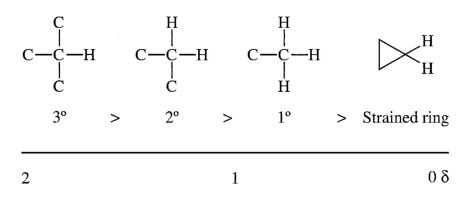NMR does not only show relative deshielding. You can use the chemical shift value itself to predict what type of enviroment it is in. Correlation charts can be used for this:
While it difficult to memorize a lot of number ranges, it is easy to get a "feel" for what regions the peaks are in, especially for the less-cluttered left half of the chart.
Notice that all protons attached to sp3 carbons are at 2-1 ppm, assuming the carbon is not attached to a heteroatom. Protons on primary carbons have a higher shift than on tertiary carbons:
This can be explained with the same reason for tertiary carbocations are more stable - alkyl group donate electrons inductively, shielding the central CH.
.pdf+-+SumatraPDF_2012-12-19_21-20-25.png)
.pdf+-+SumatraPDF_2012-12-19_21-31-36.png)
No comments:
Post a Comment